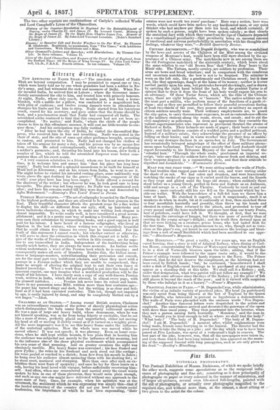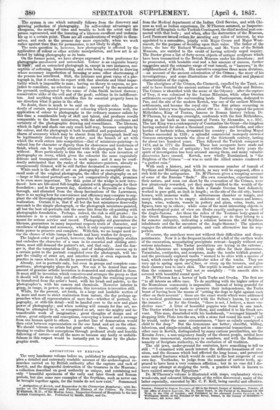lint Arts.
PICTORIAL PHOTOGRAPHY.
TICE Portrait Exhibition of Messrs. Dickinson, of which we spoke briefly the other week, suggests some speculations as to the reciprocal influences of photography and fine art; consisting as it does principally of photographs on paper or ivory coloured in the meaner of miniatures, and of larger oil-pictures, several even life-sized full-lengths, painted with the aid of photographs, or actually over photographs magnified to the required size, and without more than, at the utmost, a short sitting or .two given to the artist for the colour. The system is one which naturally follows from the discovery and growing perfection of photography. Its self-evident advantages are cheapness, the saving of time and trouble to both the artist and the person represented, and the insuring of a likeness excellent and uruleniable up to a certain point. These are all considerations of weight in themselves, and such as the present day more especially, when we work rather against time than for permanence, is not likely to slight. The main question is' however, how photography is affected by the application of colour or other artistic manipulation, and how art is affected by taking photography as its basis. On the former point, we have always expressed a firm preference for photographs uncoloured and untouched. Colour is an exquisite beauty in itsaf ; and an untouched photograph 113, except in rare instances susceptible of softening, harmonizing, and even being corrected in drawing where necessary imperfection of focusing or some other shortcoming of the process has interfered. Still, the intrinsic and great value of a photograph is, that it renders its report with that absolute and blind impartiality which is impossible to man ; having no theory to express, no prejudice to conciliate, lie selection to make ; unawed by the mountain or the pyramid, undisgusted by the name of John Smith incised thereon ; conservative alike of the evil and of the good; sublime in its indifferentism. And anything which modifies this its essential property loses in one direction what it gains in the other. No doubt, there is much to be said on the opposite side. Independently of certain special processes of colouring which promise well, the application of colour to photographs in the ordinary manner enlists by this time a considerable body of skill and talent, and produces results comparable to the finest miniatures, with the additional excellence and certainty of the photographic drawing and resemblance. The likeness, which in light and shade can only reach half-way, becomes complete by the colour, and the photograph is both beautified and popularized. Any charm of accessory which may be absent from the photograph itself can be legitimately introduced by the artist; and the branch of art with which the work enters into competition—that of miniature-painting—is valued less for character or dignity than for choiceness and tenderness of finish, which can be equally attained with the photograph for basis as without. More particularly is this the case with the new invention of photography on ivory, which gives the colourist the same exquisitely delicate and transparent surface to work upon : and it may be confidently anticipated that the ranks of the miniature-painters, already so conspicuously thinned, will be still further decimated in consequence.
While such is the effect of art on photography as exemplified on the small scale of the original photographs, the effect of photography on art —large or life-sized portrait-art—as yet comparatively slight, promises to be even more important. The thin point of the wedge is now introduced: here are life-sized full-lengths painted with photographs for their foundation; and in the present day, destitute of a Reynolds or a Gainsborough, and alienated from the cheap fascinations of the Lawrences, there is no saying how far convenience and efficiency may conspire to supplant the old thoroughgoing artist's portrait by the artistico-photographic realization. Certain it is, that if all but the best miniatures deservedly succumb to the simple photograph, or the photograph miniature-painted, all but the best oil-portraits risk the same fate from the oil-painting with photographic foundation. Perhaps, indeed, the risk is still greater : the miniature is to a certain extent a costly bauble, but the life-size is meant for serious service and record. Photographic aid guarantees the likeness, guarantees in many important respects truth of character, and excellence of design and accessory, which it only requires competent artistic power to preserve and complete. With this, we no longer need incur the chance of white lumps for hands and hazy washes for drapery. The highest order of portrait, however, that which thoroughly studies and embodies the character of a man in its essential and abiding attributes, must still demand the painter's art, and that only. And the danger is that the temptation of fatality, and of indisputable success up to a certain point in the portrait completed over the photograph, will impair the vitality of strict art, and interfere with or even supersede its practice in eases where it should be preserved inviolate. Already, not in portraits only, but even in groups and complete compositions, photography plays its part. Nor can it be denied that some amount of genuine artistic invention is demanded and embodied in these. It must still be invention which conceives and arranges the group so that It should tell its story fully and effectively, though the realizing process be transferred from the artist's hand, with his brush and palette, to the photographer's, with his camera and chemicals. However inferior in grasp, in range, in power, in aspiration, this invention is invention still. .
e, for the present, art tends, in a large and laudable section of it, more and more to strict realization from nature, the day perhaps approaches when all representation of mere fact—whether of portrait, topography, , or still-life detail—will be handed over to the new and giant power of photography; and when nothing will remain for fine art, nothing be attempted by it, or recognized as art, save the mighty and intransferable work of imagination ; great thoughts of design and of colour, great subjects and conceptions, conveying a lesson and a message from one human spirit to others. A perfect line of demarcation would then exist between representation on the one hand and art on the other. We should tolerate no artists but great artists • these of course, continuing to realize their conceptions through profound 'study and humble following of nature—and all the more so because any laxity or unfaithfulness in this respect would be instantly put to shame by the photographic truth.



































 Previous page
Previous page